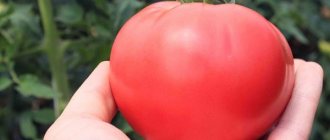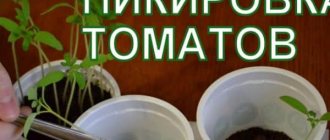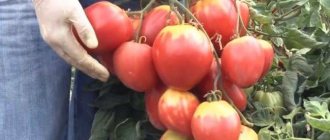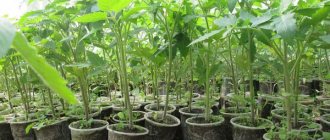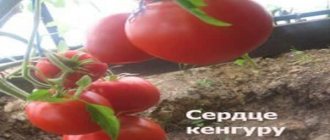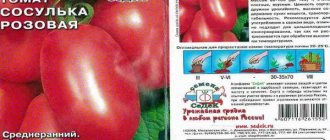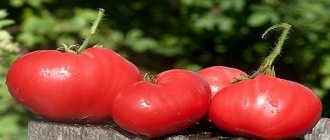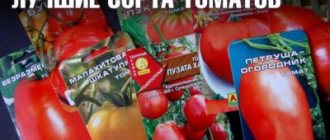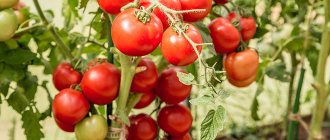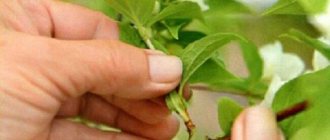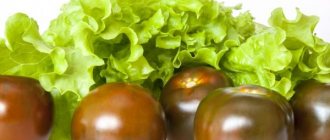Among the existing varieties of tomatoes, there are some that are not recommended for growing by novice gardeners, since their agricultural technology includes some nuances. But many varieties and hybrids do not pose any difficulties in care; they are accessible to everyone. As a rule, Dutch varieties belong to the latter category, and this includes the Tolstoy F1 hybrid.
- 2 Appearance
- 3 Advantages and disadvantages, features, differences from other varieties
- 4 Features of planting and growing Tolstoy tomatoes
- 5 Reviews
5.1 Video: a gardener’s opinion about the Tolstoy tomato
Description of the Tolstoy tomato, its characteristics, yield, growing region
Tomato Tolstoy F1 is a development of the famous company Bejo Zaden BV, located in the Netherlands. It was created mainly for the countries of Central Europe. The hybrid was named in honor of Lev Nikolaevich Tolstoy. It was registered in the State Register of the Russian Federation in 1999 and is recommended for all regions. This tomato can be grown both in film greenhouses and in unprotected soil. It has no industrial significance and is intended for small farmers, summer residents and amateur gardeners.
Tolstoy F1 belongs to the plants of the indeterminate type; the bush grows to a height of one and a half meters or more and requires mandatory staking. The leaves are of normal size, green or light green. In terms of harvest ripening, the hybrid is one of the early ripening ones: the first tomatoes are ready for consumption 110–112 days after sowing the seeds for seedlings. Fruiting is extended and continues until frost: as the fruits ripen on the lower tiers, flowers on the upper ones bloom. The fruits are collected in clusters of 10–12 pieces.
The bushes simultaneously contain tomatoes of varying degrees of ripening
The fruits are dense, round in shape, slightly flattened, with slightly noticeable ribbing. Contains two or three seed nests. The skin is dense, but not hard. The tomatoes are medium in size, leveled, and generally weigh from 80 to 120 g . The very first specimens that ripen on the lower tiers can have a mass of 2–3 times more. The color is rich red. The taste is sweet, various tasters rate it good or excellent. Gourmets testify to the fruity notes in the aroma of the fruit. Cracking is not typical for the hybrid unless there are prolonged heavy rains. The main purpose of tomatoes is fresh consumption, but excess harvest can be processed into a variety of products, including canned whole.
The crop withstands transportation very well, which tempts farmers who grow tomatoes for sale. If tomatoes are picked unripe, they “arrive” well during storage, ultimately not differing in taste from those that were picked reddened. There is evidence that in this version they can last almost until the New Year.
The yield of the hybrid, given the tallness of the bush, cannot be considered very high: according to the official document, it ranges from 3 to 6 kg/m2. However, many gardeners say that these figures are greatly underestimated . The value of this tomato lies in its very high resistance to diseases, although sometimes it is affected by late blight. In addition, Tolstoy normally tolerates a lack of sunlight, sudden cold snaps and extreme heat.
Description
Reviews from vegetable growers who have grown various varieties of tomatoes highlight plants with record yields. Moreover, in addition to high productivity, they have excellent taste and ease of care. This list includes the Tolstoy F1 tomato, produced by the Dutch company (Bejo Zaden).
It is intended for cultivation in open ground conditions, as well as in film greenhouses. The tall hybrid is distinguished by medium-early fruit ripening. The vegetative period from germination to fruiting ranges from 110 to 115 days. Powerful, highly branched bushes of this hybrid can reach a height of up to three meters. They require tying. The leaves are medium in size and light green in color. Tomato Tolstoy F1 – carpal type. The rounded fruits have a uniform red color. Their weight can reach from one hundred to one hundred and twenty grams. Two racemes are formed in the inflorescence. There can be up to twelve of them on one bush. Each cluster ripens from eight to ten fruits.
Appearance
In appearance, Tolstoy tomatoes are not unique. Many varieties and hybrids have this shape, size and color. Outwardly, these are the same tomatoes that small children become acquainted with when just learning about the world: red, flattened and round, relatively small. They are smooth; among all the specimens you rarely see a “freak” with an irregular shape or severe cracks. Like many Dutch hybrids, the Tolstoy F1 tomato has fruits described by the expression “like in the picture.”
The fruits of this tomato have a uniquely regular shape, characteristic of many other varieties.
Seedling care
After the sprouts appear, the boxes are moved to a well-lit place. Tomato Tolstoy F1, the description of which characterizes this plant as indeterminate, has rapid, unlimited growth of the main stem. Such tomato hybrids will quickly stretch if there is a lack of light.
Therefore, daylight hours should be observed for twelve or fourteen hours. If necessary, the lack of lighting is compensated for by additional illumination with fluorescent lamps. During the period of seedling growth, moderate watering is carried out and the temperature regime is observed. It will be different depending on the time of day. The daytime temperature is fourteen degrees Celsius, the night temperature is ten. When two or three true leaves appear, Tolstoy F1 tomato is picked. Reviews from experienced gardeners confirm the beneficial effects of this technique. In this case, the main root is pinched. This contributes to the formation of a more powerful root system. Seedlings are planted in separate cups or greenhouses. Further care consists of moderate watering. Before moving to a permanent growing site, seedlings are hardened off. To do this, the seedlings will need short sunbathing in the open air.
Advantages and disadvantages, features, differences from other varieties
The Tolstoy tomato is a very good hybrid, although, of course, since its appearance, many similar varieties have been bred with characteristics no worse, and often much better. However, it is still quite popular among gardeners, due to its following positive properties:
- early maturation;
- extended fruiting;
- high resistance to sudden changes in weather;
- good disease resistance;
- unpretentiousness to growing conditions, adaptability to possible gardener mistakes;
- shade tolerance;
- heat resistance;
- high transportability and long shelf life of the crop.
The negative properties of the hybrid include:
- requirement for high soil fertility;
- the possibility of late blight in certain seasons;
- the need to repeatedly tie the stems.
A feature of the Tolstoy tomato is its high tolerance to changes in weather conditions: it reacts normally to sudden cold, which, of course, does not reach frost, and to extreme heat. The bush grows normally and bears fruit in the absence of sun for a long time and even in partial shade. Even a novice gardener can grow this tomato, although he may not achieve high yields, and the fruits, if there is insufficient nutrition, may be somewhat smaller than expected according to the description.
There are many varieties of tomatoes that have fruits of similar colors and shapes, probably much more than a hundred, so it makes no sense to put the appearance and taste of tomatoes at the forefront of comparison. This hybrid is valuable precisely because of its high resistance to emerging problems in agricultural technology and its lack of capriciousness. Most Dutch tomatoes are distinguished by this. True, there is an opinion that the seeds of many of them are genetically modified, which, of course, does not add to their popularity. There is no exact information about this, and there are no such rumors regarding the Tolstoy tomato.
Now in the State Register of our country there are a dozen and a half tomatoes from the Dutch company Bejo Zaden B.V. Almost all of them are first-generation hybrids, most of which are salad crops. Approximately half of them belong to determinate species and, accordingly, the second half - to indeterminate species. There are literally only a few early ripening hybrids.
Thus, the Ritchie hybrid, registered 10 years ago, in most respects is very similar to the tomato in question, and the taste of its fruit is considered uniquely excellent. The very young hybrid Fletcher, which produces tomatoes larger than Tolstoy, is characterized by very low yield and only good taste. Thus, as strange as it may sound, apparently, there is little point in chasing imports when choosing a variety of tomatoes for planting in a summer cottage: at present, you can choose a completely suitable domestic variety that satisfies all the needs of the most demanding gardener.
Richie is almost a complete analogue of Tolstoy, but his fruits are considered more delicious
Description
To have a more accurate idea of what a Tolstoy tomato is, it is worth studying the characteristics and description of the variety and familiarizing yourself with the photo.
The fruits of the crop are round in shape, with a smooth, slightly ribbed surface on top. The minimum weight of the fetus ranges from 100 grams. All tomatoes look smooth and have a uniform bright scarlet color. They grow on a bush in the form of clusters: 6-8 tomatoes at a time.
They ripen at the same time, so harvesting can be done immediately by cutting off the brushes. The fruits have a pleasant taste. Their flesh is dense and their skin is elastic. Due to these characteristics, the fruits tolerate transportation well. During heat treatment they do not deform or crack.
The leaves are small, rich green in color.
The harvest is harvested 3-3.5 months after planting the crop in the ground. The plant bears fruit for a long time, until autumn. The variety has high productivity. You can harvest up to 5 kg of tomatoes from one bush. If the plant is grown in a greenhouse, the yield may be higher.
Tolstoy is a hybrid. Therefore, tomato has high immunity to diseases and pests. Its development and harvest are not affected by weather conditions. The culture is not afraid of rainy weather and drought. It grows well in shaded areas. The harvest will be high even with insufficient nutrition.
Features of planting and growing Tolstoy tomato
Tolstoy is a typical indeterminate tomato, and its agricultural technology fully fits into the traditions of planting and growing similar varieties and hybrids. At the same time, you can discard all those conventions that are not mandatory for most tomatoes: growing a Tolstoy tomato is accessible to even the most inexperienced gardener.
In the southernmost regions, you can grow this tomato without seedlings, simply by sowing the seeds in a garden bed when warm weather arrives. True, at the same time its advantage of early ripening is greatly offset. In most cases, seedlings are still grown, this process proceeds without any special features: it begins about two months before the intended transplantation of the seedlings into the garden bed. Seedlings are picked at the age of 10–12 days and hardened 5–7 days before planting.
Since Tolstoy tomato bushes are rather large, they are planted at distances of at least 50 cm from each other. The hybrid is quite demanding when it comes to nutrition, so the garden bed is well stocked with fertilizers. Otherwise, growing it goes without problems. The usual watering regime, fertilizing, if you want to get a richer harvest, is carried out not three times, but 4-5 times per season. Mulching the soil is encouraged: although the fruits of this tomato rarely crack, fluctuations in soil moisture do not benefit the quality of the tomatoes.
Gardeners, accustomed to order, form Tolstoy tomato bushes according to patterns familiar to indeterminates: in one or two stems. However, the experience of numerous amateurs shows that it bears fruit well even with a three-stem formation, and even with almost no pinching at all. This is one of the main advantages of the hybrid: if the vegetable grower is not yet familiar with the intricacies of growing a bush, his actions will not spoil almost anything.
Meticulous gardeners form Tolstoy bushes according to generally accepted patterns, but this is not mandatory
General characteristics
Tolstoy F1 tomato has excellent taste. The characteristics of this hybrid will be incomplete if we do not emphasize its excellent transportable qualities. In addition, the dense fruits do not overripe on the bush and do not crack. When picked unripe, they can ripen while retaining their taste. They tolerate high summer temperatures well. And at the same time, it is a cold-resistant, shade-tolerant plant with a long fruiting period. It is resistant to late blight, fusarium, cladosporiosis, verticillium blight, and leaf mosaic virus. The Tolstoy F1 tomato will delight you with an excellent stable harvest.
Reviews from gardeners say that one plant can produce fifteen kilograms of ripe sweet tomatoes. They are universal in use. The dense fruits are equally tasty in freshly prepared salads and in preparations for future use. Juicy ripe tomatoes are suitable for making tomato juice. They are also suitable for the popular preparation method - freezing.
Reviews
Planted Tolstoy F1 in 2015. Despite the weather, I knitted without skipping a beat. It led into 2 trunks, very powerful, large leaves - shortened by half. He’s really immune to diseases; he doesn’t give a damn about cladosporiosis. It has grown to the roof, about 12 brushes of 6–8 pieces have matured. Red tomatoes are fleshy, sweetish, of the same size, about 80–100 grams, something between a ball and cream. One thing is upsetting - you can’t take seeds... He probably loves food.
Cinderella
https://www.tomat-pomidor.com/forums/topic/3026-%D1%82%D0%BE%D0%BB%D1%81%D1%82%D0%BE%D0%B9-f1/
My Tolstoy F1 grew up in the OG. Purchased seedlings. There were 5 bushes growing. All five are like twin brothers. It fruited and set until the end of September or the beginning of October, until it was pulled out. I wasn't sick with anything. The weight of the fruit on the lower clusters is up to 150g, on the tops 80g. For those who like dense tomatoes for preservation.
Galina
https://www.tomat-pomidor.com/forums/topic/3026-%D1%82%D0%BE%D0%BB%D1%81%D1%82%D0%BE%D0%B9-f1/
And I like Tolstoy! But only for preservation. When fresh, it is hard and tasteless at all. But it doesn’t get sick and is productive!!
Olga
https://www.tomat-pomidor.com/forums/topic/3026-%D1%82%D0%BE%D0%BB%D1%81%D1%82%D0%BE%D0%B9-f1/
We grow the Tolstoy tomato variety in a film greenhouse. This plant has a very powerful stem. With the correct stepsoning procedure, the plant produces a very large number of fruits. The fruits grow small in size - medium. Well suited for closing in a jar - canning. The red color of the tomato is very dense and fleshy.
Starbiz
https://otzovik.com/review_1252034.html
...tomatoes of the Tolstoy F1 variety, this is a medium-early hybrid, suitable for cultivation in the Central European part of Russia, both in a greenhouse and in open ground, but in the northern regions, for example, the Leningrad region, it is still better to grow it in a greenhouse ( my friend ripens this variety only in a greenhouse, but in Voronezh it ripens well in open ground.By and large, caring for these tomatoes is the same as for all others, but the variety is very large, I usually use it for food in the summer and preserved for salads - for the winter. Make tomato paste or juice.
Vano
https://otzovik.com/review_2662481.html
Video: gardener’s opinion about the Tolstoy tomato
Tomato Tolstoy is a worthy representative of the Dutch collection of hybrids intended for cultivation in any conditions. The simplicity of his agricultural technology created Tolstoy’s high popularity, which, despite the emergence of new varieties, supports its spread in domestic gardens.
- Author: Semyon Vladimirov
Rate this article:
- 5
- 4
- 3
- 2
- 1
(0 votes, average: 0 out of 5)
Share with your friends!
Landing
- For sufficient growth and yield, the tomato must be planted in well-fertilized soil. In depleted soil it develops slowly, the number of clusters and the weight of the fruit decreases.
- It is not recommended to grow “Tolstoy” after eggplants and tomatoes; it is much better if cabbage, beets, and carrots previously grew in this place.
- An actively growing tomato requires constant feeding with fertilizers, as well as constant but moderate watering.
Growing seedlings
For greenhouse conditions, the seedling period begins at the end of February, for open ground - at the beginning of March. On average, seedling growth lasts 55 days, so you can calculate the approximate start time of sowing yourself.
Seeds are sown as follows:
Soil from a mixture of garden soil with humus and the addition of ash is poured into the seedling box. For additional processing, boiling water is used. The seeds are treated with a weak solution of manganese. To speed up germination, seeds are soaked for a day. The seeds are deepened into the soil by 1.5-2 cm, left under the film at room temperature for germination.
The temperature should not drop below. If all conditions are met, the first shoots are expected after 4 days. Boxes with shoots are placed on the sunny side. The soil is constantly moistened, avoiding overwatering and rotting. The sprouts are transplanted into a separate container with nutritious soil when 3 leaves appear on them. The surface of the earth is carefully loosened from time to time.
Bedding
It is advisable to choose a sunny place for planting. A prerequisite is the absence of frost, the temperature should not fall below 15 degrees.
The soil is first dug up and watered. Can be fertilized with organic matter. When planting in greenhouses, maintain a density of 3 bushes, and in open ground - 4 bushes per square meter.
general characteristics
Thick Botsman tomatoes are suitable for planting under film cover and in unprotected soil.
The variety is frost-resistant, so fruiting lasts until the end of October. Ripening dates are early.
The resistance of this variety to tobacco mosaic and bacterial spot only enhances its popularity. Unpretentiousness in care and agricultural technology makes it possible to grow even for beginners in the field of gardening.
Bush
The bush belongs to the determinate standard type, reaches a height of up to 70 cm. Its stems are powerful, the inflorescences are simple - they are bisexual, which ensures the production of ovaries without additional pollinators. The leaves are very large, emerald in color.
Fruit
Tomatoes of the Tolsty Botsman variety are round in shape. The average weight is 150 g. They have an unusual color: the skin is rich red, and there are small golden stripes on the surface.
The skin is dense, the flesh is juicy, with a large amount of dry matter - this increases the meatiness.
There are 4 chambers inside, they contain beige seeds.
Yield indicators
Yield characteristics depend on crop care and planting location. If all the rules of agricultural technology are followed, then up to 5 kg can be harvested from 1 m².
In open ground conditions, yields are slightly less, about 3 kg. If you grow the variety in protected ground, you can harvest 5 kg from 1 m².
Purpose of fruits
Tomatoes are versatile in gastronomic terms. They can be eaten fresh and are also great for fresh salads, sandwiches and canning.
Tomatoes of this variety contain a high concentration of vitamins and beneficial microelements, so they are suitable for baby food. Does not cause allergies, which is important for many.
Growing regions
In the southern regions, planting is carried out in open ground. If you live in the Urals, Siberia or the Far East, it is better to plant in protected soil. This will protect the vegetable crop from frosts, which occur regularly in this area.
Growing tomatoes
It is advisable to grow the “Fat Cheeks” variety through seedlings.
How to prepare seeds:
- The purchased seed material does not need to be prepared for sowing, since it was processed in production laboratories;
- However, personally collected material must be disinfected to destroy possible pathogens. To soak the seeds, use: 1% manganese solution (15 minutes), 0.5% soda solution (for 24 hours) and the drug “Fitosporin” (15-20 minutes).
Sowing seed material:
- Sowing of seed material for seedlings begins in late March;
- It is advisable to use ready-made soil for seedlings. However, garden soil needs to be disinfected. For this purpose, calcination in the oven, pouring boiling water or treatment with a concentrated manganese solution is used. Soil preparation begins 10 days before sowing. During this period, soil bacteria will multiply in it;
- Any shallow container is used as a container - boxes, peat cups, yogurt jars. The selected container is filled with prepared moist soil, the seed material is laid out on it and sprinkled with the same soil on top. The interval between seeds is maintained at 1-2 cm;
- Next, the containers are covered with film to create a greenhouse effect and left in a warm place with a temperature range of up to +30 degrees;
- The humidity level in the container should be between 80-90%. As the soil dries, moisten it with a spray bottle. If the humidity is high, the film is slightly opened to allow the contents of the container to dry. If fungus appears, the affected soil is removed and the remaining soil is treated with Fitosporin solution;
- When growing seedlings in one container, in the phase of two true leaves, the seedlings dive. Tomato seedlings are watered 2-3 days before picking to minimize trauma to the root system during transplantation. During the procedure, the seedlings are fed with mineral fertilizers;
- Subsequent plantings require 16 hours of lighting. To do this, containers are placed on southern window sills. The soil humidity level should be in the range from 40 to 50%, and the temperature range from +16 to +25 degrees.
Rules for planting seedlings:
- Transplantation to a permanent place begins in the second half of May, when it is warmed up to +18 degrees;
- Since the variety is quite heat-loving, it is better to grow it in well-warmed and illuminated areas. It is optimal if onions, cabbage or zucchini previously grew on it. It is not recommended to plant after potatoes, eggplant, physalis and pepper. In hilly areas, planting is carried out on southern slopes;
- Immediately before transplanting, add a handful of wood ash, onion peel, chopped banana peel or yeast mixture to the planting holes. All these are natural sources of potassium, which ensures normal growth of tomato crops;
- In the prepared area, the beds are placed in the direction of the sun. The row spacing is set to 60 cm, the interval between planting holes should be at least 50 cm. When planting, the recommended density must be observed, i.e. no more than 6-8 seedlings are placed per 1 m2.
Growing seedlings
At the end of February or beginning of March, seeds are planted. The best soil composition is earth, wood ash, sand and humus. To disinfect the prepared substrate, it can be calcined in the oven. The seeds are placed in the soil to a depth of 1-1.5 cm, sprinkled with soil on top and watered with heated water from a spray bottle. The containers with seeds are covered with film or glass and placed in a warm room.
After the first shoots emerge, the seedlings are placed on a windowsill or under artificial lighting. 1 month after sowing the seeds, the first fertilizer is applied. Two weeks before transplanting into the ground, seedlings should be hardened off.
Advice! In order for seedlings to grow proportionally, observe a special temperature regime: during the day - 14 degrees, at night - 10.
Description of the variety
The bushes are tall, well developed and branched, the leaves are light green, medium. The maximum growth of the plant can reach 3 meters. More often than not, a greenhouse plant is lower due to lack of space; in open ground, growth is not limited. The gardener himself can make adjustments and trim them to avoid brittleness of the plant.
The bushes require staking, so you should take care to strengthen the plants with stakes. This is necessary not only because of growth, but also because of the abundant yield.
The plant is a raceme, with 10-12 racemes on one bush. Tomatoes appear in quantities of approximately 10 pieces, 100-115 grams per bunch, the minimum possible weight is 80 grams. The largest fruits ripen on the lower branches. From one bush you can harvest more than 10 kg of tomatoes.
Fruits equally well both in greenhouses and in open ground. Partial shade does not interfere with the quality and quantity of the harvest. It is also resistant to summer heat. Not affected by cladosporiosis, fusarium and verticillium, tobacco mosaic.
The variety is considered mid-early; it takes about 105 days from germination to the first fruits. Fruits all season.
Tomato "Tolstoy" can be considered a prolific variety, resistant to temperature changes and typical diseases that affect other types of tomatoes. The gardener will not need much effort to care for this plant.
Fruit
Each tomato is smooth, round, slightly flattened on top. The fruits are bright red, uniformly colored, with a dense but not hard skin. “Tolstoy” is a Dutch hybrid tomato, so the tomatoes are equally uniform, differing only in size. Suitable for transportation, do not wrinkle. You can put whole brushes in boxes. Long-term storage possible. Green fruits collected in boxes ripen on their own without losing their taste.
Reviews on growing the Lev Tolstoy variety
Ivan L., Volgograd: “Tomatoes are one of my favorite vegetables; in the garden I grow more than 100 roots of varieties 6 - 8. Among them are large ones for salads, and small ones for pickling. The Lev Tolstoy variety is one of my favorites. I like that it gives a good harvest throughout the season, and I always have fresh tomatoes on the table from July to September.”
Ekaterina M., Simferopol: “Our summer is warm and lasts a long time, so it seems stupid to me not to take advantage of this and not plant vegetables in the garden. I enjoy harvesting and preparing for the winter, and then I take jars out of the cellar and treat them to guests. This year I heard good reviews about Lev Tolstoy tomatoes and decided to try them. I was satisfied: the plants were unpretentious, there was no need to fight diseases, the harvest was good, and the tomatoes themselves were delicious. The whole family enjoyed the fresh fruits. Next year I’ll plant more.”
Vladimir M., Shubino: Every year I buy new varieties of tomatoes and grow them separately. Some I like and buy their seeds for next season, but some don’t pass the test. Lev Tolstoy's tomatoes left an average impression. On the one hand, they have good yield and keeping quality, but on the other hand, they are demanding on the soil and do not like frost. It is better to grow these tomatoes in greenhouses. Nevertheless, I received a harvest, albeit less than I expected.”
Vasilisa N., Oktyabrsk: “I liked the Lev Tolstoy variety for its keeping quality and pleasant taste. Having collected the fruits in September, I was still able to prepare fresh salads until mid-November, which is very valuable in our region. After looking at the descriptions, I found out that the variety has good nutritional value due to its high content of carotene and microelements. This is a good source of nutrients for my family.”
Breeders are constantly working to create varieties suitable for different regions, including the coldest. Tomato Lev Tolstoy f1 has absorbed all the best qualities that tomatoes can have. It is unpretentious, produces an excellent harvest, tolerates various temperatures, and also suffers little. Therefore, it can even be used for cultivation in Siberia and the Urals.
Diseases and pests
The variety is resistant to major nightshade diseases. However, information about tomato diseases in greenhouses and how to combat them may be useful to you.
Read about the most important of them:
- Alternaria blight.
- Fusarium.
- Verticillium.
- Late blight and measures to protect against it.
As well as varieties that are resistant to late blight and not susceptible to other diseases, varieties that, while resistant to infection, can give a good harvest result.
When growing tomatoes, it is important to know what type of plant each variety belongs to. Read all about indeterminate varieties, as well as about determinate, semi-determinate and super-determinate varieties
Read all about indeterminate varieties, as well as determinate, semi-determinate and super-determinate varieties.
As for pests, the most common of them are the Colorado potato beetle, mole cricket, slugs, and spider mites. And the most effective means for their destruction are insecticides.
Gardeners who have tried the “Fat Jack” variety on their plots include it in the list of regularly planted early, large-fruited tomatoes. Farmers can recommend this variety for its ability to fill the market early with fresh, tasty tomatoes that tolerate transportation well.
